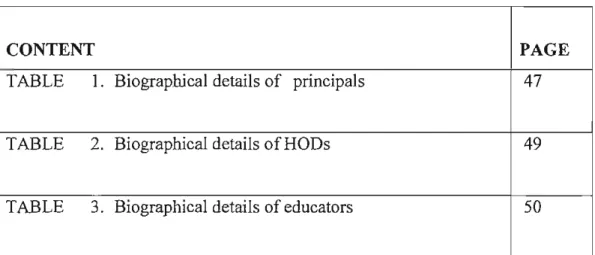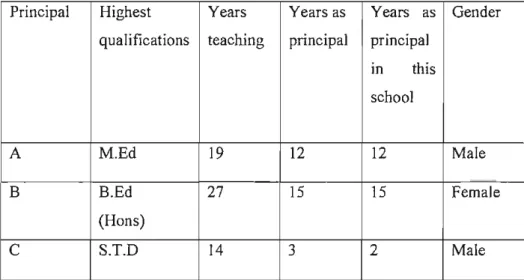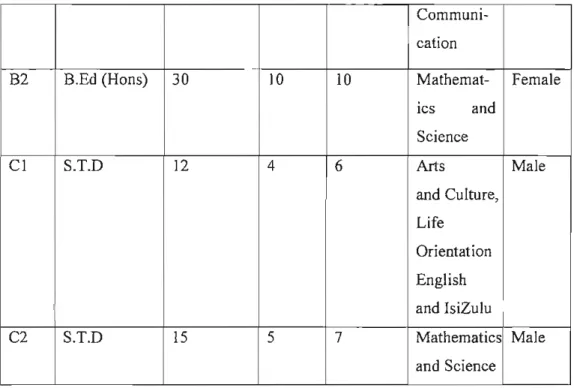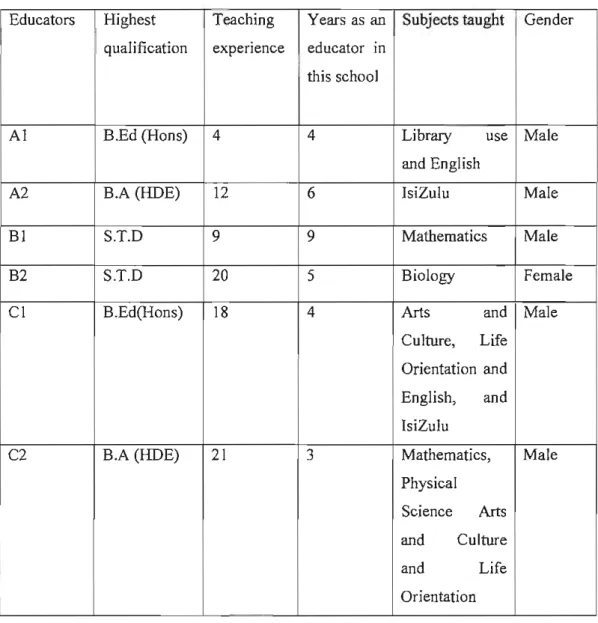As a result, the Department of Education (DOE) has introduced policies such as the Integrated Quality Management Systems (IQMS) to improve the quality of education and for school improvement. GGBS policy was adopted from an industrial philosophy called Total Quality Management (TQM) which sought to improve production in industries. The study used quality management and total quality management to frame the study and understand the daily lives of the participants in the three schools studied.
This study examined the relationship between quality management and school improvement in three secondary schools in Umlazi district. 5.4.2 'How does the understanding of 'quality management' and 'school improvement' facilitate the maintenance of quality in three secondary schools in Umlazi district?'

CHAPTER!
ORIENTATION AND BACKGROUND
- Introduction
- Background to the study
- Critical questions
- Significance of the study
- School Improvement
- Methodology
- Delimitation of the study
- The structure of the study
- Conclusion
- CHAPTER 2
Mentz (1999) adds that for the success of quality management in an organization there must be continuous improvement, a shared vision, a culture of teaching and learning, a learning environment and school effectiveness as part of school improvement. The DoE, for example, has introduced several quality management policies aimed at the management of South African public schools. This study focused on educators' understanding of the concept of quality management and the relationship between quality management and school improvement in three secondary schools in Umlazi district, which were generally considered to be weak.
What do educators in three secondary schools in Umlazi district understand by the terms "quality management" and "school improvement". Further, it is hoped that this study will reveal trends that may be associated with poor student performance in Umlazi district.
LITERATURE REVIEW
Introduction
The concept of quality
Deming's efforts to promote the restructuring of Japanese managerial culture led to a conceptualization of how organizations could operate effectively. Rampa (2005) believes that one of the reasons for the establishment of this philosophy was that Japanese products could not compete with the world markets in Europe after World War II. In order to improve quality, one of the main steps taken by the Japanese was to obtain the services of Deming, who then developed an ideal approach to management, later known as TQM in Japan.
Fidler (2002) embraces Deming's (I986) explanation that TQM philosophy and practice enable educators to achieve goals they set for school improvement. Thus, TQM requires a commitment to continuous improvement, which requires improving the quality required by the customer or customer.
Quality mauagement
Therefore it is a final goal of the school to provide the opportunity to learn and develop their capacities and skills. Parents are the school's most important external customers because they share a special bond with the school. Shaba (2003) further states that it is the parent's duty to ensure that students actively participate in the school's curricular and extracurricular activities.
Suppliers, the school and the DoE should work to provide the best service to satisfy the needs of the internal customers (Van der Westhuizen, 2003). It is also essential that the principal motivates educators to improve their education so that they can help upgrade the school.
School improvement
- Vision and mission statement
According to Greenwood and Gaunt (1994), continuous improvement is about continuously improving the quality of the product in the workplace. By promoting the culture of teaching and learning, the DoE seeks to establish confidence in the education system by removing the persistent habits and values that pose stumbling blocks to learning and teaching (Rampa, 2005). For example, the international research was conducted in the United States of America (US) and concerns the ISO 9000 quality management system.
Rampa's research is very similar to this study in that both studies seek to understand the relationship between quality management and school improvement for three township schools in Umlazi. The present study focuses on the quality management activities carried out within the school for school improvement by the principal, HODs and teachers.
Conclusion
RESEARCH DESIGN AND METHODOLOGY
- Introduction
- The research design
- The research paradigm underpiuuing methodology
- Methods of data elicitation
- Selection
- Ethical issues
- Limitations of the study
- Conclusion
Furthermore, semi-structured interviews provide space for the researcher to explain the questions to the participants and ensure that they understand what is being asked of them (De Vos, 2000). Before recording the interview, the researcher asked the participants for permission to record the discussions. The reason for this process is that the researcher believes that the school environment is extremely important for the success of the school.
After the interviews were transcribed, the researcher gave the copy of the interviews to the participants for confirmation. To make this study credible, the researcher used a variety of measures to ensure the reliability of the findings. Credibility refers to the ability of the researcher to produce findings that are convincing and credible (Guba & Lincoln, 1985).
Conformability was ensured by returning to the participants to check the researcher's initial interpretation of the content of the interview. Reliability refers to the extent to which the reader can be convinced that the findings did occur as the researcher says they did (Yin, 2004). The researcher took a number of steps to ensure that no harm was done to the participants.
During the data collection process, the researcher assured the participants of the confidentiality of the information they provided. The researcher asked the principals of the investigated schools to participate in the research and provide 2 HODs and 2 educators for interview. This limitation became an advantage for the researcher as it allowed time for observation while waiting for participants.
PRESENTATION AND DISCUSSION OF DATA
Themes emerging from the data
- Section A: Different understandings of quality management and school improvement
- Section E: Team work
Data analysis also found that educators did not have a clear understanding of quality management. In the definitions they gave it was clear that they did not consider that they as educators were also responsible for quality management. Educators and SMT members blamed each other for the lack of quality management and school improvement in their schools.
According to SMT members, teachers were often absent from work and did not bring doctor's reports. According to teachers and HODs, school leaders have not put enough effort into the success of their schools. In all three schools, the directors often owned the schools because they did not want to delegate.
The data analysis shows that teachers and HOD participants blamed their principals for the lack of school improvement in their schools. Teachers, on the other hand, knew that it was important for a school to have these statements, but they did not see them functioning in their school. Teachers at the three schools surveyed said they were not motivated to teach and improve their teaching.
The participants also emphasized that they were not motivated due to a lack of external motivation. Only the principals were happy about the involvement of SGB in the improvement and quality of the school. In the studied schools, there was insufficient communication between parents and the school.
Conclusion
To invite parents about anything, schools used the traditional method of writing letters to them or telling students orally. This way of communication had shortcomings; these included the fact that students often did not invite or tell their parents. Principals raised work commitments as another reason commonly given by parents for not attending meetings called by the school.
All of the above conditions indicate the extent to which parents see the importance of their participation in school affairs.
CHAPTERS
FINDINGS, ANALYSIS AND CONCLUSSION
Introduction
- Leadership
The schools studied could improve their infrastructure by following quality management and school improvement policies. 5.4.1 What teachers in three secondary schools in Umlazi district understand by the terms 'quality management' and 'school improvement'. It was found that participants differed in their understanding of the concepts of quality management and school improvement.
SMT members mentioned that they follow the DoE's quality maintenance policy. Educators mentioned that it was not their job to know and understand quality management because they were not part of maintenance substitution treatment. In addition, principals and other members of the SMT have similar views on the effectiveness of quality management.
Whenever there is a lack of communication in an organization, the chances of effective quality management and school improvement are non-existent. Rather than building and supporting teamwork in the schools studied, finger-pointing prevailed between educators and SMT members. Through this study it was clear that DHPs were keen to have a positive teaching and learning culture, however, they seemed to be struggling to understand quality management and school improvement.
Quality management and school improvement seem to need to be communicated to all stakeholders. Quality management and school improvement must be clearly understood by all stakeholders if quality teaching and learning is to be ensured. There is a link between quality management and school improvement when school stakeholders work together for effective learning.
Successful School Improvement and the District Office of Education in Southern Aji·ica: Some New Proposals. Schools as organization: 'the breakdown of the culture of learning and teaching' in South African schools. Reengineering and total management in schools: how to reform and restructure your school to meet the challenges of the future.
Total Quality Management in Self-Financing Technical Institutions: Quality Functional Deployment (QDF) and Force Field Analysis Approach.
LIST OF APPENDICES
Participants' biographical data
Interview guide for principals and HODs
What do you do to ensure that the goals (vision and mission statement of the school) are supported and met.
Interview guide for educators
What do you do to ensure that the school's goals, vision and mission statement are supported and met?
Approval letter to conduct research from KwaZulu-
Natal DoE
UNIVERSITY OF
KWAZULU-NATAL
That he/she as a researcher must submit a copy of the written consent of the Department to the Head of the concerned Institution before any research may be undertaken at a departmental institution. >-. Ms T Mxumalo was given special permission to conduct his/her research during .. official contact as it was believed that their presence would not interrupt education programmes. If education programs are interrupted, he/she must therefore conduct his/her research during non-official contacts. );, No school is expected to participate in the research during the fourth school term, as this is the critical period for schools to focus on their examinations.
Letter to participants in schools
The data collected during the interview will be analyzed and published in the complete research document that will be placed in libraries and given to educational institutions so that other schools can benefit from it. If you agree to be a participant, please complete the consent form on the next page. You are welcome to ask questions about the research and consult with someone before completing the consent form.


